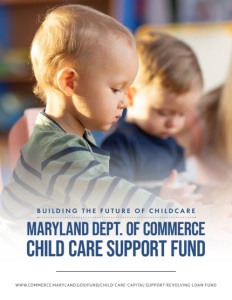Maryland Dept. of Commerce – Child Care Support Fund
Building the Future of Childcare
Supporting childcare by providing crucial financial assistance to providers across the state.
The Maryland Department of Commerce’s Child Care Support Fund addresses a crucial need within the state, especially highlighted in the aftermath of the COVID-19 pandemic. Designed to facilitate access to reliable childcare, this initiative, deeply rooted in legislative action, operates through a revolving loan program that benefits childcare providers by offering unsecured, interest-free loans, making it easier for them to establish and maintain quality childcare facilities.
“Emerging from the pandemic, it became clear there were significant obstacles for parents either returning to work or entering the workforce for the first time,” Andy Fish, Senior Director at the Office of Finance Programs within the Maryland Department of Commerce, explains. “One major hurdle was the lack of trustworthy and accessible childcare facilities. We saw that ensuring such facilities were available and appealing was a way to alleviate some of these challenges.”
Fish elaborates on the Child Care Support Fund: “The fund is a simple revolving loan program. As payments are returned to the fund, we can re-loan those to other childcare providers, ensuring the program’s sustainability. These loans are unsecured and interest-free, making them very borrower-friendly.” This approach is especially beneficial since many childcare providers struggle to secure financing from traditional commercial banks or other sources at reasonable rates and terms.
The Impact of the Pandemic on Program Genesis
The Child Care Support Fund’s roots can be traced back to the period following the COVID-19 pandemic. The global crisis emphasized the need for robust childcare solutions, catalyzing the creation of this vital program. “We’re in the second year of the program right now,” Fish states, reflecting on its relatively recent inception. In its first year, 67 childcare providers qualified for a loan from across the state.”
“This year, 2024, is the second year for it,” Fish continues, “and the applications have been very robust, with over 106 complete applications and $10 million of funding available.” The program’s design is inherently sustainable; as Fish explains, “With the payments that come back into the fund over time, we hope to continue this resource and be able to loan those funds to additional projects that providers might have in the future.”
The popularity of the Child Care Support Fund has been overwhelmingly positive. “It’s been mostly on the existing facilities, particularly those that needed to renovate and maybe freshen up to ensure their facility was vibrant,” Fish notes. Many of these facilities had been “starved for capital historically over several years,” lacking the resources to make necessary improvements.
The feedback has been exceptionally positive, with providers appreciating the program’s accessibility and lack of financial burdens. “People recognize the program’s value with no fees to apply and no interest rate attached,” Fish says. “They recognize the benefits are worth going through the application process.” This user-friendly approach has made the program a lifeline for many childcare providers, helping them to thrive in challenging times.
Expanding Access and Ensuring Equity
In the wake of the pandemic, the Maryland Department of Commerce’s Child Care Support Fund aims to ensure that all communities, particularly underserved ones, have access to quality childcare. This goal aligns with the fund’s broader vision of supporting public and private childcare providers, ensuring a comprehensive approach to meet diverse needs across the state.
“The childcare provider just has to have a current license through MSDC and participate in the MSDC child care scholarship program,” Fish explains, highlighting the essential eligibility criteria. He also emphasizes the fund’s focus on equity, stating, “We’ve got to give priority to those located in childcare deserts or other underserved communities.” This approach ensures that low-income areas and children with special needs are not overlooked, providing critical support where needed.
Regarding eligibility, Fish mentions, “Providers serving children ages two and younger get priority in that ranking.” This focus on the youngest age group is driven by a priority list from MSDC, ensuring that those in the most formative stages of development receive the necessary support.
The fund’s inclusivity extends to various childcare scenarios. “As long as they’ve got that current license through MSDC and make slots available to parents using the child care scholarship program, providers serving half-day kindergarten or daycare would be eligible,” Fish explains. This flexibility is vital in accommodating the wide range of childcare needs across different communities.

Capital Improvements and Beyond
In the changing panorama of dual-income households, access to quality child care is a necessity and a linchpin of economic stability. The Maryland Department of Commerce’s Child Care Support Fund addresses this by providing financial assistance for a range of capital expenses, ensuring that facilities can meet the growing demand and standards of care.
“So, in terms of what the funds can be used for,” Fish begins, “we’ve seen applications mainly focusing on renovations to current facilities. This includes repairs, replacing equipment like tables, chairs, toys, and upgrading playground facilities.” These updates are crucial, ensuring children have a safe and enriching environment. Moreover, the fund supports expansions, allowing providers to add capacity, which is increasingly important as more families require childcare services.
Beyond the apparent benefits of renovations and upgrades, the program also advances broader community support. “Overall, the biggest benefit ties into the support of the local community,” Fish emphasizes. “It ensures that people are networking in the ecosystem for their career interests while their children are well-served and well-cared for. It all comes down to peace of mind.”
Regarding safety, Fish highlights that while the Maryland State Department of Education (MSDE) ensures providers meet extensive safety requirements, the loan can be used for further safety enhancements. “If there’s a need to upgrade plumbing, electricity, or other safety aspects, the loan proceeds can be utilized to make those improvements,” he says. This ensures that facilities meet regulatory standards and provide the safest possible environment for children.
Financial Benefits and Application Simplicity
One of the most compelling aspects of the Child Care Support Fund is its financial accessibility. Designed to be user-friendly and supportive, the program offers several fiscal benefits, making it an attractive option for childcare providers across Maryland.
“The application is straightforward,” Fish notes. “It’s through an online portal, and we open that application window at certain times throughout the year. We advertise that on our website.” This straightforward approach ensures that providers are well-informed about the process and requirements. Fish continues, “We do our best to outline the requirements and materials the applicant needs to provide so they are ready to enter the portal. They’ve readied all their materials, attachments, etc., and hopefully, it can be a brief experience going through that application portal.”
Convenience extends to the loan settlement process as well. “The completion of the documents is all through DocuSign, so electronically,” Fish explains. This eliminates the need for providers to visit a location to settle a loan physically, enhancing the program’s accessibility.
Addressing the financial specifics, Fish points out, “There are no rates of interest attached to the loan, and there’s no penalty for prepayment. It’s amicable in that regard.” This structure encourages providers to repay the loan as their finances allow, without the burden of additional costs. “We encourage those who have the means to prepay early to feel free to do so,” Fish adds, highlighting the program’s flexibility. For those who cannot, the loan can be repaid over five years through manageable monthly payments.
Spreading the Word: Outreach and Community Engagement
The Maryland Department of Commerce has implemented a strategic marketing approach to ensure the Child Care Support Fund reaches its intended audience.
“There are two leading industry associations for the childcare community in Maryland,” Fish explains. “One of our colleagues visits their annual events twice yearly and talks about the program and what it can be used for.” This face-to-face interaction allows the department to address questions directly and gather feedback to improve the application process. Fish emphasizes, “That boots-on-the-ground approach to talk about it and get the word out through the industry association has been crucial.”
Beyond industry events, the department maintains robust community ties, ensuring that information about the fund permeates Maryland. “The committees are really what commerce is all about because we’ve got to be neutral in that regard,” Fish notes. With representatives in all counties and Baltimore City, the department ensures that local economic development offices are well-informed about available state resources, including the Child Care Support Fund.
Fish emphasizes the importance of these relationships, saying, “The regional representatives from Commerce are out and about meeting with their peers in the county and city of Baltimore economic development offices. They talk about different resources the state has to make sure they’re all aware of them.”

Vision for the Future: Expanding Capacity and Enhancing Accessibility
As the Child Care Support Fund continues to garner positive reception, the Maryland Department of Commerce is focused on its future growth and refinement.
Fish outlines the department’s ambitions, saying, “We’re hoping to see the continued expansion of the capacity of the available childcare slots. As our workforce grows, we’d like to see the number of slots grow.” This growth is essential to meet the increasing demand for childcare services as more parents return to the workforce.
Collaboration with the Maryland State Department of Education (MSDE) remains a cornerstone of the program’s strategy. “We’re going to work closely with MSDE to hear their feedback and what else might be needed in that regard,” Fish explains. This partnership ensures the program adapts to the evolving needs of childcare providers and maintains its relevance.
Additionally, input from industry associations is invaluable. Fish emphasizes the importance of this feedback loop, stating, “When you combine those facets along with the feedback that we get from the industry associations, we’ll reassess things and look at where we can tweak things while remaining within the guardrails of the program itself.” This iterative process aims to continuously enhance the program, focusing on underserved communities and simplifying the application process.
Looking ahead, Fish is optimistic about the long-term benefits and sustainability of the Child Care Support Fund. “Each loan can be a five-year maximum, and we’re in the program’s second year,” he notes. “As new loans are made and payments come back to the fund, you can see a vibrant future for it.” Fish also reveals plans for the near future, sharing, “We hope to open the program in the fall for another round of loans. That would be delivered in 2025, marking the program’s third year.”
By expanding capacity, refining processes, and maintaining strong community ties, the Maryland Department of Commerce will ensure that the Child Care Support Fund remains a critical support system for childcare providers, enabling them to thrive and meet the needs of Maryland’s working families.
AT A GLANCE
Maryland Dept. of Commerce – Child Care Support Fund
What: A financial assistance program aimed at supporting childcare providers through interest-free loans for renovations, expansions, and facility improvements
Where: Maryland, USA
Website: https://commerce.maryland.gov/fund/child-care-capital-support-revolving-loan-fund


